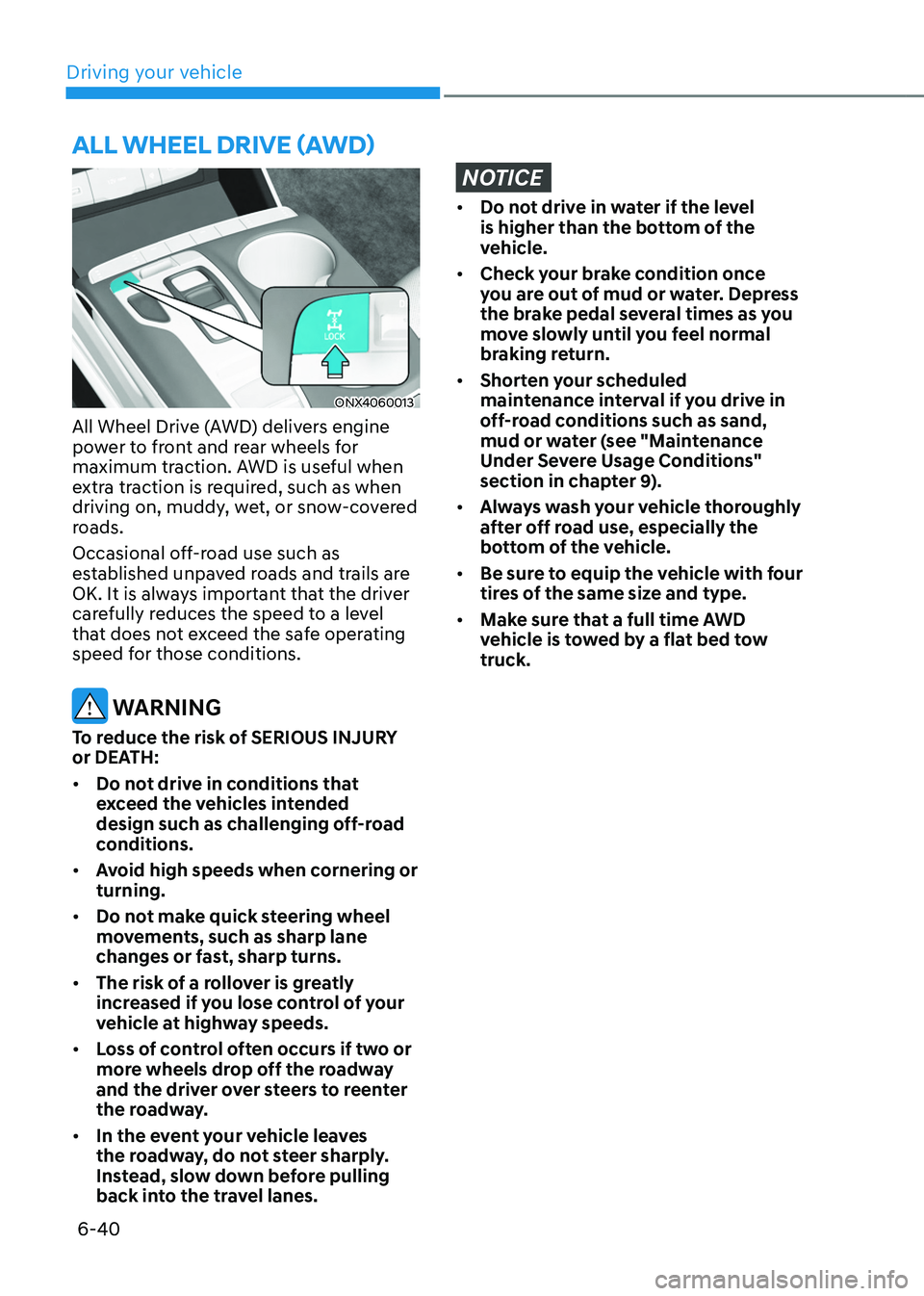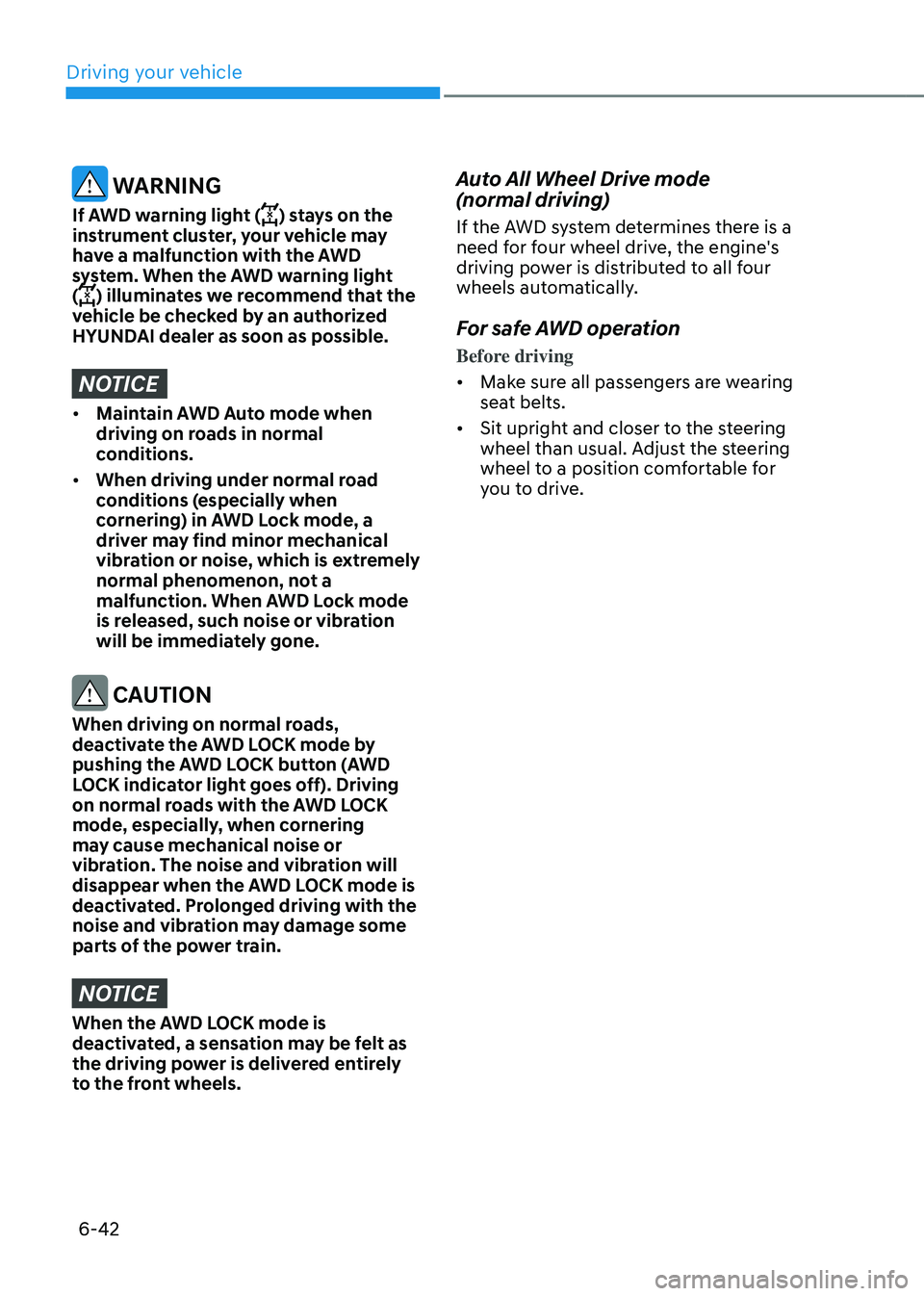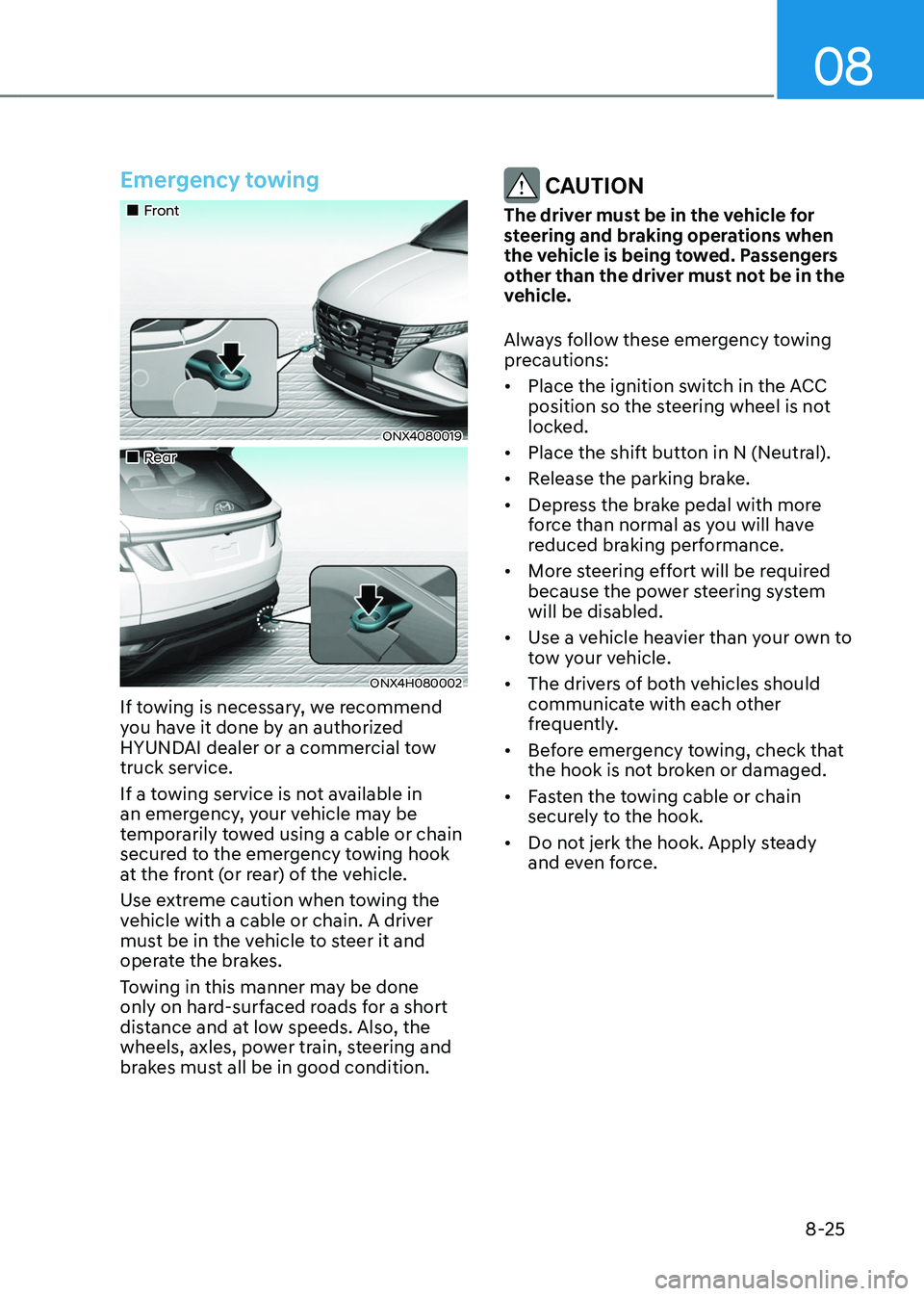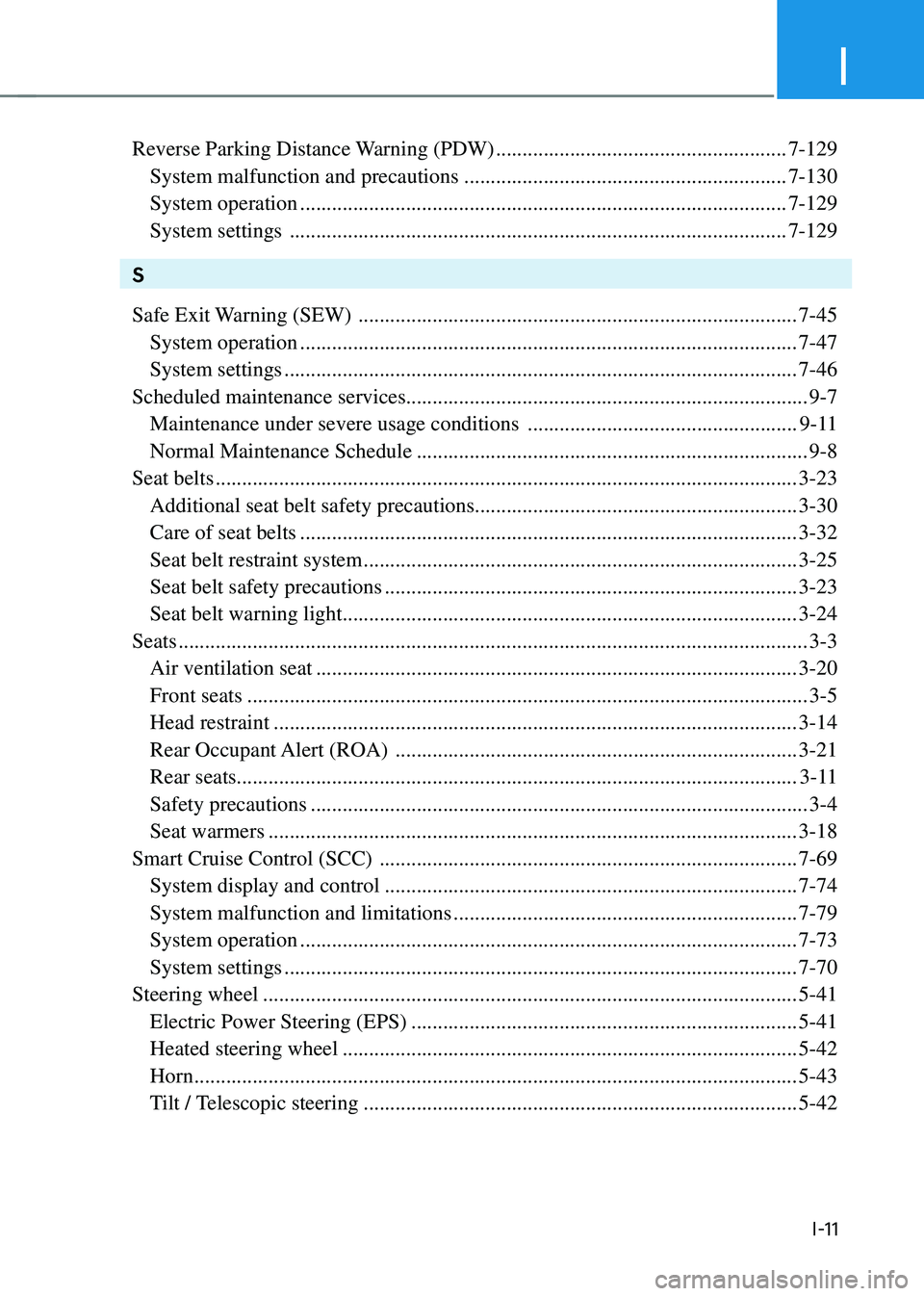2021 HYUNDAI TUCSON HYBRID power steering
[x] Cancel search: power steeringPage 327 of 630

Driving your vehicle
6-40
ONX4060013
All Wheel Drive (AWD) delivers engine
power to front and rear wheels for
maximum traction. AWD is useful when
extra traction is required, such as when
driving on, muddy, wet, or snow-covered
roads.
Occasional off-road use such as
established unpaved roads and trails are
OK. It is always important that the driver
carefully reduces the speed to a level
that does not exceed the safe operating
speed for those conditions.
WARNING
To reduce the risk of SERIOUS INJURY
or DEATH:
• Do not drive in conditions that
exceed the vehicles intended
design such as challenging off-road
conditions.
• Avoid high speeds when cornering or
turning.
• Do not make quick steering wheel
movements, such as sharp lane
changes or fast, sharp turns.
• The risk of a rollover is greatly
increased if you lose control of your
vehicle at highway speeds.
• Loss of control often occurs if two or
more wheels drop off the roadway
and the driver over steers to reenter
the roadway.
• In the event your vehicle leaves
the roadway, do not steer sharply.
Instead, slow down before pulling
back into the travel lanes.
NOTICE
• Do not drive in water if the level
is higher than the bottom of the
vehicle.
• Check your brake condition once
you are out of mud or water. Depress
the brake pedal several times as you
move slowly until you feel normal
braking return.
• Shorten your scheduled
maintenance interval if you drive in
off-road conditions such as sand,
mud or water (see "Maintenance
Under Severe Usage Conditions"
section in chapter 9).
• Always wash your vehicle thoroughly
after off road use, especially the
bottom of the vehicle.
• Be sure to equip the vehicle with four
tires of the same size and type.
• Make sure that a full time AWD
vehicle is towed by a flat bed tow
truck.
aLL WHeeL dRiVe (aWd)
Page 329 of 630

Driving your vehicle
6-42
WARNING
If AWD warning light () stays on the
instrument cluster, your vehicle may
have a malfunction with the AWD
system. When the AWD warning light
(
) illuminates we recommend that the
vehicle be checked by an authorized
HYUNDAI dealer as soon as possible.
NOTICE
• Maintain AWD Auto mode when
driving on roads in normal
conditions.
• When driving under normal road
conditions (especially when
cornering) in AWD Lock mode, a
driver may find minor mechanical
vibration or noise, which is extremely
normal phenomenon, not a
malfunction. When AWD Lock mode
is released, such noise or vibration
will be immediately gone.
CAUTION
When driving on normal roads,
deactivate the AWD LOCK mode by
pushing the AWD LOCK button (AWD
LOCK indicator light goes off). Driving
on normal roads with the AWD LOCK
mode, especially, when cornering
may cause mechanical noise or
vibration. The noise and vibration will
disappear when the AWD LOCK mode is
deactivated. Prolonged driving with the
noise and vibration may damage some
parts of the power train.
NOTICE
When the AWD LOCK mode is
deactivated, a sensation may be felt as
the driving power is delivered entirely
to the front wheels.
Auto All Wheel Drive mode
(normal driving)
If the AWD system determines there is a
need for four wheel drive, the engine's
driving power is distributed to all four
wheels automatically.
For safe AWD operation
Before driving
• Make sure all passengers are wearing
seat belts.
• Sit upright and closer to the steering
wheel than usual. Adjust the steering
wheel to a position comfortable for
you to drive.
Page 545 of 630

08
8-25
Emergency towing
„„Front
ONX4080019
„„Rear
ONX4H080002
If towing is necessary, we recommend
you have it done by an authorized
HYUNDAI dealer or a commercial tow
truck service.
If a towing service is not available in
an emergency, your vehicle may be
temporarily towed using a cable or chain
secured to the emergency towing hook
at the front (or rear) of the vehicle.
Use extreme caution when towing the
vehicle with a cable or chain. A driver
must be in the vehicle to steer it and
operate the brakes.
Towing in this manner may be done
only on hard-surfaced roads for a short
distance and at low speeds. Also, the
wheels, axles, power train, steering and
brakes must all be in good condition.
CAUTION
The driver must be in the vehicle for
steering and braking operations when
the vehicle is being towed. Passengers
other than the driver must not be in the
vehicle.
Always follow these emergency towing
precautions:
• Place the ignition switch in the ACC
position so the steering wheel is not
locked.
• Place the shift button in N (Neutral).
• Release the parking brake.
• Depress the brake pedal with more
force than normal as you will have
reduced braking performance.
• More steering effort will be required
because the power steering system
will be disabled.
• Use a vehicle heavier than your own to
tow your vehicle.
• The drivers of both vehicles should
communicate with each other
frequently.
• Before emergency towing, check that
the hook is not broken or damaged.
• Fasten the towing cable or chain
securely to the hook.
• Do not jerk the hook. Apply steady
and even force.
Page 628 of 630

I
I-11
Reverse Parking Distance Warning (PDW) .......................................................7-129
System malfunction and precautions .............................................................7-130
System operation ........................................................................\
....................7-129
System settings ........................................................................\
......................7-129
S
Safe Exit Warning (SEW)
........................................................................\
...........7-45
System operation ........................................................................\
......................7-47
System settings ........................................................................\
.........................7-46
Scheduled maintenance services ........................................................................\
.... 9-7
Maintenance under severe usage conditions ...................................................9-11
Normal Maintenance Schedule ........................................................................\
..9-8
Seat belts
........................................................................\
......................................3-23
Additional seat belt safety precautions .............................................................3-30
Care of seat belts ........................................................................\
......................3-32
Seat belt restraint system ........................................................................\
..........3-25
Seat belt safety precautions ........................................................................\
......3-23
Seat belt warning light ........................................................................\
..............3-24
Seats
........................................................................\
...............................................3-3
Air ventilation seat ........................................................................\
...................3-20
Front seats ........................................................................\
..................................3-5
Head restraint ........................................................................\
...........................3-14
Rear Occupant Alert (ROA) ........................................................................\
....3-21
Rear seats ........................................................................\
..................................3-11
Safety precautions ........................................................................\
......................3-4
Seat warmers ........................................................................\
............................3-18
Smart Cruise Control (SCC)
........................................................................\
.......7-69
System display and control ........................................................................\
......7-74
System malfunction and limitations .................................................................7-79
System operation ........................................................................\
......................7-73
System settings ........................................................................\
.........................7-70
Steering wheel
........................................................................\
.............................5-41
Electric Power Steering (EPS) ........................................................................\
.5-41
Heated steering wheel ........................................................................\
..............5-42
Horn ........................................................................\
..........................................5-43
Tilt / Telescopic steering ........................................................................\
..........5-42